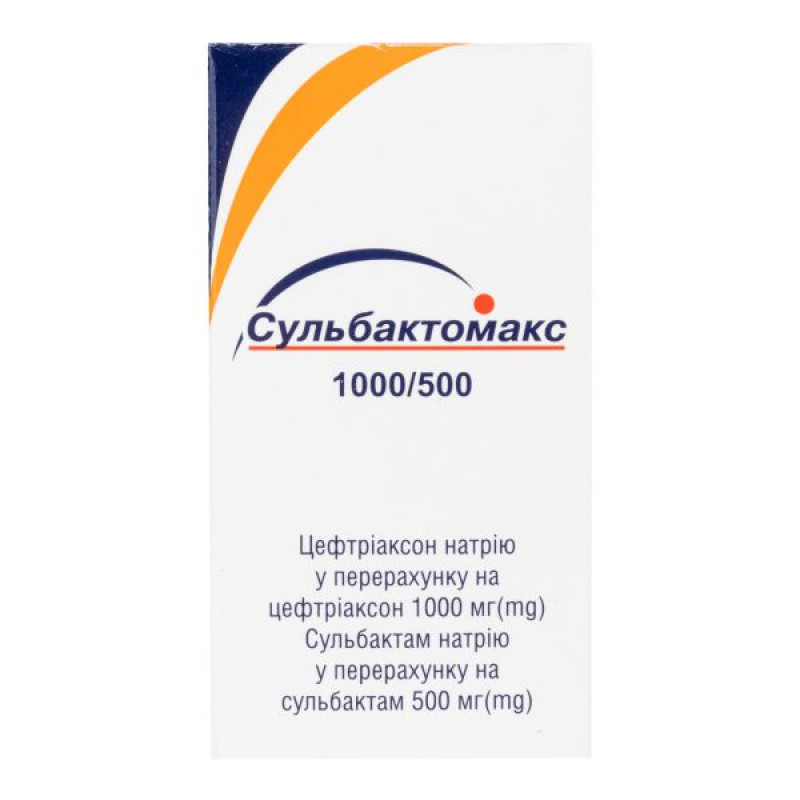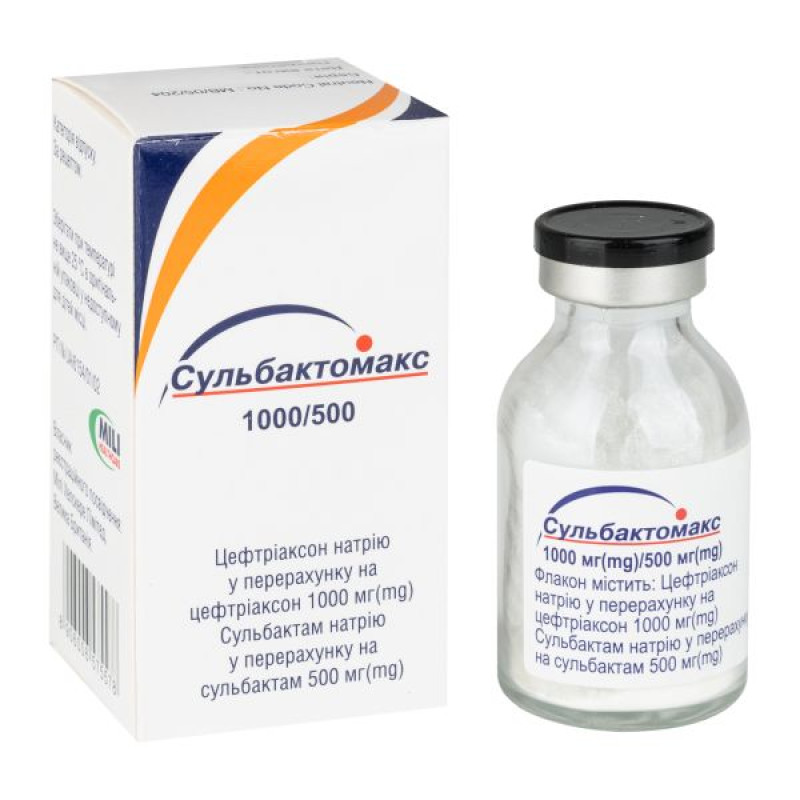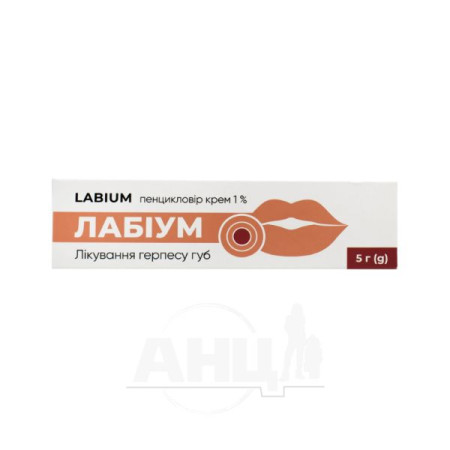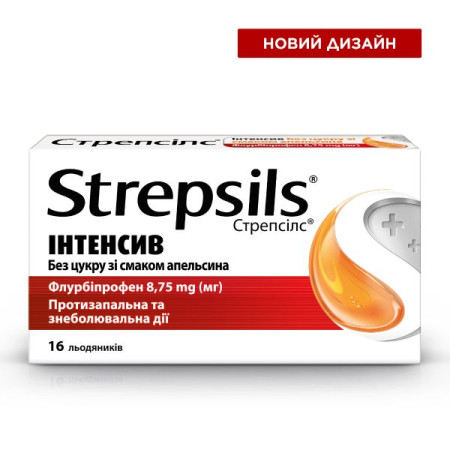Sulbactomax powder for solution for injection 1000 mg + 500 mg vial 20 ml
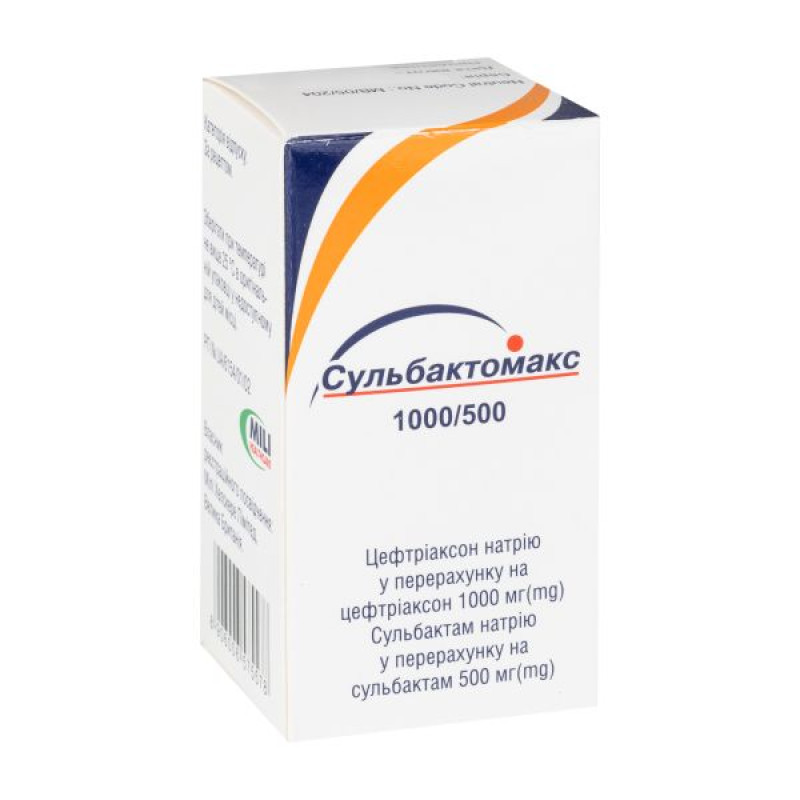
Instructions Sulbactomax powder for solution for injection 1000 mg + 500 mg vial 20 ml
Composition
active ingredients: ceftriaxone, sulbactam;
1 bottle of 20 ml contains: ceftriaxone sodium equivalent to ceftriaxone 1000 mg, sulbactam sodium equivalent to sulbactam 500 mg;
1 bottle of 10 ml contains: ceftriaxone sodium equivalent to ceftriaxone 500 mg, sulbactam sodium equivalent to sulbactam 250 mg.
Dosage form
Powder for solution for injection.
Main physicochemical properties: white, pale yellow/cream crystalline, slightly hygroscopic powder.
Pharmacotherapeutic group
Antibacterials for systemic use. Ceftriaxone, combinations. Third generation cephalosporins. ATX code J01D D54.
Pharmacological properties
Pharmacodynamics.
Sulbactomax is a combination drug containing:
ceftriaxone (third-generation cephalosporin), which has a broad spectrum of action against sensitive microorganisms in the stage of active multiplication by inhibiting the biosynthesis of cell membrane mucopeptide;
Sulbactam - is an irreversible inhibitor of most major beta-lactamases produced by penicillin-resistant microorganisms. It has significant antibacterial activity only against Neisseriaceae, Acinetobacter calcoaceticus, Bacteroides spp., Branhamella catarrhalis, and Pseudomonas cepacia. Sulbactam synergistically interacts with penicillins and cephalosporins, and also binds to some penicillin-inactivating proteins, so some sensitive strains show increased sensitivity to the combination compared to the beta-lactam antibiotic monodrug.
Sulbactam is active against (including beta-lactamase-producing resistant strains):
gram-positive (aerobes): Staphylococcus aureus (methicillin-sensitive strains), coagulase-negative staphylococci, Streptococcus pyogenes (beta-hemolytic, group A), Streptococcus agalactiae (beta-hemolytic, group B), beta-hemolytic streptococci (except groups A, B), Streptococcus viridans, Streptococcus pyogenes. It should be borne in mind that methicillin-resistant strains of Staphylococcus spp., as well as Enterococcus faecalis, Enterococcus faecium, Listeria monocytogenes are resistant to cephalosporins, including ceftriaxone;
gram-negative (aerobes): Aeromonas hydrophila, Alcaligenes faecalis, Alcaligenes odorans, alcaligen-like bacteria, Citrobacter diversus (including S. amalonaticus), Citrobacter freundii, Escherichia coli, Enterobacter aerogenes, Enterobacter cloacae, Enterobacter spp. (others), Haemophilus ducreyi, Haemophilus influenzae, Haemophilus parainfluenzae, Klebsiella oxytoca, Klebsiella pneumoniae, Moraxella catarrhalis (formerly Branhamella catarrhalis), Moraxella osloensis, Moraxella spp. (others), Morganella morganii, Neisseria gonorrhoeae, Neisseria meningitidis, Plesiomonas shigelloides, Proteus mirabilis, Proteus penneri, Proteus vulgaris, Pseudomonas fluorescens, Pseudomonas spp. (others), Providentia rettgeri, Providentia spp. (others), Salmonella typhi, Salmonella spp. (non-typhoid), Serratia marcescens, Serratia spp. (others), Shigella spp., Vibrio spp., Yersinia enterocolitica, Yersinia spp. (others).
Sulbactomax, like ceftriaxone, is used to treat gonorrhea and syphilis, since Treponema pallidum is sensitive to ceftriaxone in vitro and in animal experiments, and clinical trials show that ceftriaxone is highly effective against primary and secondary syphilis;
anaerobes: Bacteroides spp. (including some strains of B. fragilis.), Clostridium spp. (except C. difficile), Fusobacterium spp. (except F. mortiferum and F. varium), Gaffkia anaerobica (formerly called Peptococcus), Peptostreptococcus spp.
Note: Many strains of beta-lactamase-producing Bacteroides spp., including B. fragilis, as well as Clostridium difficile, are resistant to ceftriaxone.
Since the main active ingredient of the drug is ceftriaxone, susceptibility to Sulbactam is determined by susceptibility to ceftriaxone, which can be determined by the disk diffusion method.
or by serial dilution method on agar or broth.
Pharmacokinetics.
The pharmacokinetics of ceftriaxone are nonlinear.
All major pharmacokinetic parameters, except for the half-life (T1/2), are dose-dependent. Absorption: after intramuscular administration, the maximum concentration is reached after 2-3 hours. The bioavailability of the drug after intramuscular administration is 100% (for ceftriaxone).
After administration at a dose of 1-2 g, ceftriaxone penetrates well into tissues and body fluids. After intravenous administration, ceftriaxone rapidly penetrates into the cerebrospinal fluid, where bactericidal concentrations against sensitive microorganisms are maintained for 24 hours.
Ceftriaxone is reversibly bound to albumin. Due to the lower concentration of albumin in tissue fluid, the proportion of free ceftriaxone in it is higher than in blood plasma. The maximum concentration (Cmax) in cerebrospinal fluid is reached approximately 4 hours after intravenous administration and averages 18 mg/l. In bacterial meningitis, the average concentration of ceftriaxone in cerebrospinal fluid is 17% of the concentration in blood plasma, in aseptic meningitis - approximately 4%. In patients with meningitis in adults due to
2-24 hours after administration of a dose of 50 mg/kg body weight, ceftriaxone concentrations in the cerebrospinal fluid are many times higher than the minimum inhibitory concentrations for the most common pathogens of meningitis.
Ceftriaxone crosses the placental barrier and in small concentrations penetrates into breast milk.
50-60% of ceftriaxone is excreted unchanged in the urine, and 40-50% unchanged in the bile. The half-life of ceftriaxone in adults is approximately 8 hours. Total plasma clearance is 10-22 ml/min, renal clearance is from 5 to 12 ml/min. In newborns, approximately 70% of the dose is excreted by the kidneys. In infants in the first 8 days of life, as well as in the elderly (from 75 years), the half-life is on average
2 times longer. In patients with impaired renal or hepatic function, the pharmacokinetics of the drug changes slightly, only a slight increase in the half-life is noted. In cases of impaired renal function alone, the proportion of ceftriaxone excreted in the bile increases, in cases of impaired hepatic function alone, the proportion of ceftriaxone excreted by the kidneys increases.
Indication
Lower respiratory tract infections;
acute bacterial otitis media;
infections of soft tissues, skin;
kidney and urinary tract infections;
infections of bones and joints;
septicemia;
infections of the abdominal organs (peritonitis, infections of the biliary tract and digestive tract)
tract);
meningitis;
gonorrhea;
prevention of infections in surgery.
Contraindication
Hypersensitivity to ceftriaxone or any other cephalosporin. History of severe hypersensitivity reactions (e.g. anaphylactic reactions) to any other type of beta-lactam antibacterial agent (penicillins, monobactams and carbapenems); renal and/or hepatic insufficiency; history of gastrointestinal disease, especially non-specific ulcerative colitis, enteritis or colitis associated with the use of antibacterial drugs.
Ceftriaxone is contraindicated:
Premature newborns ≤ 41 weeks of gestational age (gestational age + age after birth)*
For full-term newborns (age ≤ 28 days):
with hyperbilirubinemia, jaundice, hypoalbuminemia, or acidosis, as bilirubin binding is likely to be impaired in these conditions*
who require (or are expected to require) intravenous calcium preparations or infusions of calcium-containing solutions, as there is a risk of precipitation of ceftriaxone calcium salt (see sections "Special warnings and precautions for use" and "Adverse reactions").
* In vitro studies have shown that ceftriaxone may displace bilirubin from its association with serum albumin, leading to a possible risk of bilirubin encephalopathy in such patients.
Before intramuscular administration of ceftriaxone, it is essential to exclude contraindications to the use of lidocaine when used as a diluent (see section "Special instructions for use"). See the instructions for medical use of lidocaine, especially contraindications.
Ceftriaxone solutions containing lidocaine should never be administered intravenously.
Interaction with other medicinal products and other types of interactions
Diluents containing calcium, such as Ringer's solution or Hartmann's solution, should not be used to dissolve ceftriaxone in vials or to dilute the reconstituted solution for intravenous administration due to the possibility of precipitation of ceftriaxone calcium salts. Precipitation of ceftriaxone calcium salts may also occur when ceftriaxone is mixed with calcium-containing solutions in the same intravenous infusion system. Ceftriaxone should not be administered intravenously simultaneously with calcium-containing solutions, including calcium-containing solutions for long-term infusion, such as parenteral nutrition solutions, using a Y-line. However, in all patients, except neonates, ceftriaxone and calcium-containing solutions may be administered sequentially, one after the other, provided that the system is thoroughly flushed with a compatible fluid between infusions. In vitro studies using adult and neonatal cord blood plasma have shown that neonates are at increased risk of precipitation of ceftriaxone calcium salt (see sections “Method of administration and dosage”, “Contraindications”, “Special precautions for use”, “Adverse reactions”, “Incompatibility”).
Concomitant use of the drug with oral anticoagulants may increase the antivitamin K effect and the risk of bleeding. It is recommended to frequently check the international normalized ratio and adjust the dose of the antivitamin K agent appropriately both during and after ceftriaxone therapy (see section "Adverse reactions").
There is conflicting evidence regarding the potential for increased renal toxicity of aminoglycosides when used with cephalosporins. In such cases, the recommendations for monitoring aminoglycoside levels (and renal function) in clinical practice should be carefully followed.
Ceftriaxone should not be mixed with amsacrine, vancomycin, fluconazole, and aminoglycosides.
With the simultaneous use of high doses of ceftriaxone and such potent diuretics as
Furosemide no renal dysfunction was observed.
Ceftriaxone does not contain the N-methylthiotetrazole group, which could cause ethanol intolerance, as well as bleeding, characteristic of some other cephalosporins.
In an in vitro study, antagonism was observed when chloramphenicol was used in combination with ceftriaxone. The clinical significance of this finding is unknown.
There are no reports of interactions between ceftriaxone and oral calcium-containing products, and no interactions between ceftriaxone given intramuscularly and calcium-containing products (intravenously or orally).
False-positive Coombs test results may occur in patients receiving ceftriaxone.
Ceftriaxone, like other antibiotics, may cause false-positive test results for galactosemia.
Similarly, non-enzymatic methods for measuring urine glucose may give false positive results. For this reason, enzymatic methods should be used during ceftriaxone therapy.
Bacteriostatic agents may interfere with the bactericidal effect of cephalosporins.
Ceftriaxone may reduce the effectiveness of hormonal oral contraceptives. Therefore, it is recommended to use additional (non-hormonal) methods of contraception during treatment and for 1 month after treatment.
Probenecid does not affect the excretion of ceftriaxone.
Application features
Hypersensitivity reactions.
As with other cephalosporins, cases of anaphylactic reactions (including anaphylactic shock) with fatal outcomes have been reported with ceftriaxone, even in the absence of a detailed medical history. Before initiating treatment, it should be established whether the patient has a history of severe hypersensitivity reactions to ceftriaxone, other cephalosporins or other types of beta-lactam agents. Ceftriaxone should be used with caution in patients with a history of non-severe hypersensitivity to other beta-lactam agents.
If allergic reactions occur, the drug should be discontinued immediately and appropriate treatment should be prescribed.
The likelihood of anaphylactic reactions is increased in patients with a history of anaphylaxis and in those suffering from hypersensitivity reactions to various allergens; use with caution in patients with a tendency to allergic diatheses.
Cases of serious skin adverse reactions [Stevens-Johnson syndrome or Lyell's syndrome/toxic epidermal necrolysis and drug reaction with eosinophilia and systemic symptoms (DRESS syndrome)] have been reported in association with ceftriaxone treatment and may be life-threatening or fatal, but the frequency of these events is unknown (see section 4.8).
Encephalopathy
Encephalopathy has been reported with ceftriaxone (see section 4.8), particularly in elderly patients with severe renal impairment (see section 4.2) or central nervous system disorders. If ceftriaxone-related encephalopathy is suspected (e.g., decreased level of consciousness, altered mental status, myoclonus, convulsions), discontinuation of ceftriaxone should be considered.
Jarisch-Herxheimer reaction.
Some patients with spirochetal infections may develop a Jarisch-Herxheimer reaction shortly after initiation of ceftriaxone therapy. This reaction is usually self-limiting or resolves with symptomatic treatment. If this reaction occurs, the antibiotic may not be discontinued.
The drug may increase prothrombin time. Therefore, if vitamin K deficiency is suspected, prothrombin time should be determined.
Colitis/overgrowth of non-susceptible microorganisms.
Clostridium difficile-associated diarrhea (CDD) has been reported with virtually all antibacterial agents, including ceftriaxone and sulbactam, and can range in severity from mild to fatal colitis. Antibacterial agents alter the normal flora of the colon, leading to overgrowth of Clostridium difficile. Clostridium difficile produces toxins A and B, which contribute to CDD. Strains of Clostridium difficile that overproduce toxins are associated with increased morbidity and mortality, as these infections may be antimicrobial-resistant and require colectomy. Clostridium difficile-associated diarrhea should be considered in all patients receiving antibiotics. A detailed medical history should be taken, as CDD may occur within 2 months of discontinuation of antibacterial agents. Consideration should be given to discontinuing ceftriaxone therapy and initiating appropriate anti-CDD agents. Medications that inhibit peristalsis should not be used.
As with the use of other antibacterial agents, superinfections caused by microorganisms insensitive to the drug may occur.
During prolonged use of ceftriaxone, it may be difficult to control non-susceptible organisms. Therefore, close monitoring of patients is necessary. Appropriate measures should be taken if superinfection occurs.
Spectrum of antibacterial activity.
Ceftriaxone has a limited spectrum of antibacterial activity and may not be suitable for use as monotherapy in the treatment of certain types of infection unless the causative agent is already confirmed (see section 4.2). In polymicrobial infections where ceftriaxone-resistant organisms are suspected, the use of additional antibiotics should be considered.
Gallstone disease.
In the event of shadows on the sonogram, the possibility of precipitation of the calcium salt of ceftriaxone should be considered. Shadows, mistakenly considered as gallstones, have been observed on sonograms of the gallbladder, and their frequency increased with the use of ceftriaxone at a dose of 1 g/day and above. Particular caution should be observed when using the drug in children. Such precipitates disappear after cessation of ceftriaxone therapy.
In rare cases, the formation of precipitates of ceftriaxone calcium salt has been accompanied by symptoms. In the presence of symptoms, conservative non-surgical treatment is recommended and the physician should decide to discontinue the drug based on the results of the benefit-risk assessment of the individual case (see section "Adverse reactions").
Bile stasis.
Isolated cases of pancreatitis, possibly secondary to biliary obstruction, have been reported in patients receiving ceftriaxone. Most of these patients had risk factors for cholestasis and biliary sludge formation, such as previous significant therapy, severe illness and total parenteral nutrition. It cannot be excluded that the formation of biliary precipitates due to Sulbactomax may be a precipitating or additional factor in the development of this disorder.
Kidney stone disease.
Cases of kidney stones have been reported, which resolved after discontinuation of ceftriaxone (see section 4.8). If symptoms are present, an ultrasound examination should be performed. The decision to use the drug in patients with a history of kidney stones or hypercalciuria should be made by the physician based on the results of a benefit-risk assessment of the individual case.
Children.
Ceftriaxone, which is part of the drug, can displace bilirubin from its association with serum albumin. In this regard, the use of ceftriaxone is contraindicated in premature and full-term newborns who are at risk of developing bilirubin encephalopathy (see section "Contraindications").
Severe renal and hepatic insufficiency.
In case of severe renal and hepatic insufficiency, careful clinical monitoring of the safety and efficacy of the drug is recommended (see section "Method of administration and dosage").
In patients with impaired renal function, provided that liver function is normal, the dose of Sulbactomax does not need to be reduced. In renal failure (creatinine clearance below
10 ml/min) it is necessary that the daily dose of ceftriaxone does not exceed 2 g.
In patients with impaired liver function, provided that renal function is preserved, there is no need to reduce the dose of Sulbactomax.
In cases of simultaneous severe liver and kidney pathology, the concentration of ceftriaxone in the blood serum should be regularly monitored. In patients undergoing hemodialysis, there is no need to change the dose of the drug after this procedure.
Caution should be exercised when administering ceftriaxone to patients with renal insufficiency who are receiving aminoglycosides and diuretics concurrently.
Interaction with drugs containing calcium.
When ceftriaxone is used in patients of any age, it should not be mixed or administered simultaneously with any intravenous solutions containing calcium, even if different infusion systems are used or the drugs are administered at different infusion sites. However, in patients 28 days of age and older, ceftriaxone and calcium-containing solutions may be administered sequentially, one after the other, provided that the drugs are administered through different infusion systems at different body sites or that the infusion system is replaced or thoroughly flushed with saline between administrations to prevent the formation of a precipitate. For patients who require continuous infusions of calcium-containing solutions for total parenteral nutrition (TPN), healthcare professionals may prescribe alternative antibacterial agents that do not carry a similar risk of precipitate formation. If the use of ceftriaxone in patients requiring continuous nutrition is deemed necessary, PPH solutions and ceftriaxone may be administered simultaneously, albeit through different infusion systems and into different body sites. Alternatively, the PPH solutions may be withheld during the ceftriaxone infusion and the infusion systems flushed between administrations (see sections Contraindications, Adverse Reactions and Incompatibilities).
Immune-mediated hemolytic anemia.
Cases of immune-mediated haemolytic anaemia have been reported in patients receiving cephalosporin antibacterial agents, including ceftriaxone (see section 4.8). Cases of severe haemolytic anaemia, including fatalities, have been reported in both adult and paediatric patients.
If a patient develops anemia while taking ceftriaxone, the diagnosis of cephalosporin-associated anemia should be considered and ceftriaxone should be discontinued until the etiology is determined.
Long-term treatment.
During long-term treatment, blood counts should be monitored regularly.
Sodium.
Ceftriaxone sodium and sulbactam sodium contain sodium, which should be taken into consideration by patients on a controlled sodium diet.
Impact on serological test results.
When using Sulbactomax, the Coombs test may give false-positive results. Ceftriaxone may also cause false-positive results in tests for galactosemia (see section "Adverse reactions").
False-positive results may be obtained when determining glucose in urine by non-enzymatic methods. During the use of Sulbactomax, glucose levels in urine should be determined by enzymatic methods of analysis (see section "Adverse reactions").
Use of lidocaine.
If lidocaine solution is used as a diluent, ceftriaxone can only be administered intramuscularly. Before administering the drug, it is necessary to take into account the contraindications to the use of lidocaine, precautions and other relevant information given in the instructions for medical use of lidocaine (see section "Contraindications"). Lidocaine solution should never be administered intravenously.
Disposal of the medicinal product.
Release of the medicinal product into the environment should be minimised. The medicinal product should not be disposed of via sewage systems or household waste. Any unused medicinal product at the end of treatment or after the expiry date should be returned in the original packaging to the supplier (doctor or pharmacist) for proper disposal. For disposal, use the so-called "waste collection system" if available.
Use during pregnancy or breastfeeding
Pregnancy.
Ceftriaxone crosses the placental barrier. There are limited data from the use of ceftriaxone in pregnant women. Animal studies do not indicate direct or indirect harmful effects with respect to embryonal/fetal, perinatal or postnatal development. Ceftriaxone should be used during pregnancy, particularly in the first trimester, only if the benefit outweighs the risk.
Breast-feeding.
Ceftriaxone is excreted in breast milk in low concentrations, but no effects on the breastfed infant are expected at therapeutic doses. However, the risk of diarrhoea and fungal infections of the mucous membranes cannot be excluded. The possibility of sensitization should be considered. A decision must be made whether to discontinue breast-feeding or to discontinue/abstain from ceftriaxone therapy taking into account the benefit of breast-feeding for the child and the benefit of therapy for the woman.
Fertility.
Reproductive studies have shown no evidence of adverse effects on male or female fertility.
Ability to influence reaction speed when driving vehicles or other mechanisms
No relevant studies have been conducted. Due to the possibility of side effects such as dizziness, Sulbactomax may affect the ability to drive or operate machinery. Patients should be careful when driving or operating machinery.
Method of administration and doses
Administer intravenously or intramuscularly. Before use, skin tests are performed for sensitivity to the antibiotic and to lidocaine.
Adults and children over 12 years of age: 1-2 g (as ceftriaxone) once a day (every 24 hours). In severe cases or infections with pathogens that are less sensitive to ceftriaxone, the daily dose may be increased to 4 g (as ceftriaxone).
Newborns, infants and children under 12 years of age.
Below are the recommended doses for once-daily use.
Neonates (up to 14 days): Doses are based on ceftriaxone: 20-50 mg/kg body weight
1 time per day. The daily dose should not exceed 50 mg/kg of body weight. There are no differences in the dosage of the drug for full-term and premature infants.
Ceftriaxone is contraindicated for use in neonates ≤ 28 days of age who require (or are expected to require) treatment with intravenous calcium-containing solutions, including continuous intravenous calcium-containing infusions, e.g. parenteral nutrition, due to the risk of precipitation of ceftriaxone calcium salts (see section "Contraindications").
Newborns from 15 days of age and children up to 12 years of age. Doses are based on ceftriaxone: 20-80 mg/kg body weight once daily. Children weighing more than 50 kg should be given adult doses.
The total daily dose for children should not exceed 2 g (as ceftriaxone).
Intravenous administration of doses above 50 mg/kg (in terms of ceftriaxone) is carried out drip, slowly (over 30-60 minutes).
Elderly patients: No dose adjustment is required in elderly patients.
The duration of treatment depends on the course of the disease. After the body temperature normalizes and the test results confirm the absence of the pathogen, it is necessary to continue using the drug for at least another 48-72 hours.
Combination therapy.
Given the data on the mutual enhancement of the action of ceftriaxone and aminoglycosides with simultaneous use against many gram-negative microorganisms, they can be used in severe, life-threatening infections caused by Pseudomonas aeruginosa. However, it should be borne in mind that increased efficacy of such combinations is not always predictable. Due to the physical incompatibility of ceftriaxone and aminoglycosides, they should be administered separately in the recommended doses for them.
Dosage in special cases.
Meningitis
For bacterial meningitis in infants and children aged 15 days to 12 years, treatment should be initiated at a dose of 100 mg/kg (not to exceed 4 g as ceftriaxone) once daily. Once the pathogen has been identified and its susceptibility determined, the dose can be reduced accordingly. The best results have been achieved with the following duration of treatment:
Neisseria meningitidis 4 days
Streptococcus pneumoniae 7 days
Haemophilus influenzae 6 days
Sensitive Enterobacteriaceae 10-14 days.
Lyme borreliosis: adults and children – 50 mg/kg (highest daily dose – 2 g) once a day for 14 days.
Gonorrhea caused by strains that produce or do not produce penicillinase: a single intramuscular injection of 250 mg of the drug.
Prevention of postoperative infections. The doses are given based on ceftriaxone. Depending on the degree of risk of infection, administer 1-2 g (in terms of ceftriaxone) of the drug once 30-90 minutes before the start of the operation. In operations on the colon and rectum, simultaneously (but separately) administer one of the 5-nitroimidazoles (for example, ornidazole).
Renal impairment. No dose reduction is required if liver function remains normal. Only in cases of pre-terminal renal failure with creatinine clearance less than 10 ml/min should the daily dose not exceed 2 g (as ceftriaxone).
Patients on dialysis do not need additional administration of the drug after dialysis, but it is necessary to monitor the concentration of ceftriaxone in the blood serum (adjust the dose if necessary), since the rate of excretion in such patients may decrease.
The daily dose of Sulbactomax in patients on dialysis should not exceed 2 g.
Impaired liver function. No dose reduction is required if renal function remains normal.
Severe renal or hepatic insufficiency
Plasma ceftriaxone concentrations should be monitored regularly and the dose adjusted if necessary, as clearance may be reduced in such patients.
Method of reconstitution and administration. As a general rule, the solution should be used immediately after preparation. The solution retains its physical and chemical stability for 6 hours at room temperature or for 24 hours at 5 °C. Depending on the concentration and storage time, the color of the solution may vary from pale yellow to amber. The color change does not affect the efficacy or tolerability of the drug.
For intramuscular injections, dissolve the contents of the vial in 3.5 ml of 1% lidocaine solution or
5 ml of water for injection; injection into the center of the large muscle. It is recommended to inject no more than 1 g at one site.
The use of lidocaine requires a preliminary test to determine individual sensitivity to this drug.
For intravenous injections, dissolve the contents of the vial in 10 ml of water for injection; administer intravenously slowly (over 2-4 minutes).
Intravenous infusion should last at least 30 minutes. To prepare the solution, dissolve the contents of the vial in 40 ml of one of the following calcium-free infusion solutions:
5% glucose solution;
0.9% sodium chloride solution;
5% glucose solution + 0.225% sodium chloride solution;
5% glucose solution + 0.9% sodium chloride solution;
water for injection.
Diluents containing calcium, such as Ringer's solution or Hartmann's solution, should not be used to dissolve Sulbactomax in vials or to dilute the reconstituted solution for intravenous administration due to the possibility of calcium precipitates forming.
ceftriaxone salts. The occurrence of precipitates of calcium salts of ceftriaxone can also occur when mixing Sulbactomax with solutions containing calcium in the same infusion system for intravenous administration. Sulbactomax should not be administered simultaneously
intravenously with calcium-containing solutions, including long-term calcium-containing infusions, e.g. parenteral nutrition. However, except in neonates, ceftriaxone and calcium-containing solutions may be administered sequentially if the infusion line is thoroughly flushed with a compatible solution between infusions (see Interactions with other medicinal products and other forms of interaction).
Children
The drug is used in pediatric practice.
Contraindicated in neonates ≤ 28 days of age when treatment with intravenous solutions containing calcium is required (or expected to be required), including intravenous infusions containing calcium, e.g. parenteral nutrition, due to the risk of precipitation of ceftriaxone calcium salts (see "Method of administration and dosage").
Cases of precipitates in the lungs and kidneys, which have resulted in fatalities, have been described in newborns and premature infants when ceftriaxone and calcium preparations were administered concomitantly. In some of these cases, the same intravenous infusion systems were used for ceftriaxone and calcium-containing solutions, and precipitates were observed in some intravenous infusion systems.
Overdose
Symptoms: there is limited information on cases of overdose. In case of overdose, the manifestation of adverse reactions may be increased. In case of overdose, nausea, vomiting, diarrhea may occur.
Treatment: hemodialysis or peritoneal dialysis are not effective. There is no specific antidote. Treatment of overdose is symptomatic.
Side effects
Infections and infestations: candidiasis, genital mycosis, secondary fungal infections and infections caused by resistant microorganisms, pseudomembranous colitis, superinfections.
From the blood and lymphatic system: eosinophilia, neutropenia, leukopenia, leukocytosis, lymphopenia, granulocytopenia, anemia, including hemolytic anemia, thrombocytopenia, thrombocytosis, basophilia, increase/decrease in prothrombin time,
coagulation disorders, hypoprothrombinemia, agranulocytosis. During long-term treatment,
regularly monitor blood counts.
Gastrointestinal: loose stools, diarrhea, nausea, vomiting, flatulence, stomatitis, taste disturbance, glossitis; pancreatitis, possibly secondary to biliary obstruction, gastrointestinal bleeding. The role of ceftriaxone-induced precipitates in the development of pancreatitis cannot be excluded; pseudomembranous enterocolitis has been reported.
From the hepatobiliary system: pseudocholelithiasis of the gallbladder, precipitates of ceftriaxone calcium salt in the gallbladder with corresponding symptoms in children, reversible cholelithiasis in children, increased activity of hepatic transaminases and alkaline phosphatase, hyperbilirubinemia, kernicterus; frequency unknown - hepatitis1, cholestatic hepatitis1,2.
Skin and subcutaneous tissue disorders: skin rash; allergic dermatitis; itching; urticaria; edema including angioedema; acute generalized exanthematous pustulosis, exanthema;
There are no reviews for this product.
There are no reviews for this product, be the first to leave your review.
No questions about this product, be the first and ask your question.







